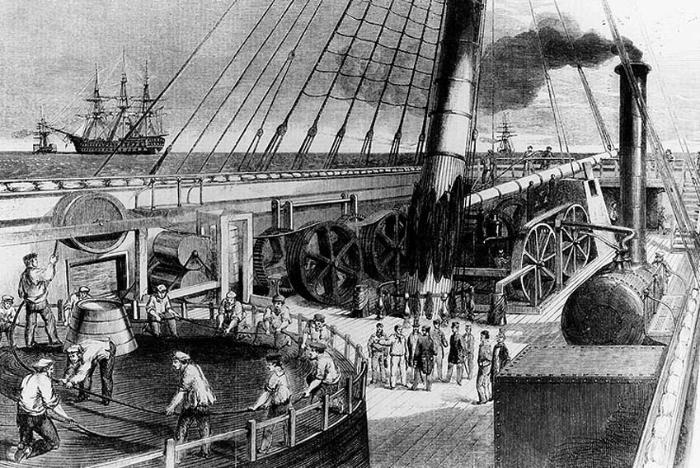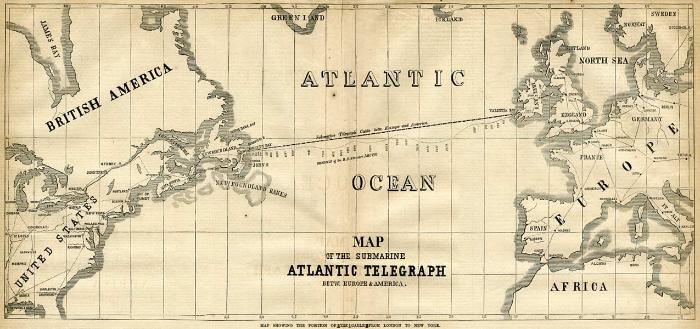How did the brave engineers of the 19th century manage to lay the first transatlantic telegraph cable in the history of communication? The question “What hath God wrought?” was the very first message to be sent using a commercial teletype, often known as a telegraph, in the year 1844. Around the year 1860, the practice of communicating over copper wires had already become commonplace. But the actual process of placing the wires was fairly difficult at times. The traditional mail soon became too slow, not in the least due to the ever-increasing presence of railways. Communication via the use of electrical impulses had contributed to the provision of a world that is capable of delivering rapid communications. But, even this cutting-edge technology would eventually hit its constraints, namely those posed by the Atlantic Ocean.
Today it is conceivable to build cables over water; since 1850, one has been spanning the English Channel to link London and Paris. However, the ocean presents a different challenge than a smaller body of water would.
Up until 1858, there were several attempts made to lay a telegraph cable over significant bodies of water on the continent of North America. In 1855, an attempt to run a cable over the Cabot Strait located in Canada was proven unsuccessful.

First Stop: Canada, Followed by the Continents
A telegraph engineer by the name of Frederick Newton Gisborne was the first to install an undersea telegraph cable that connects North America to the rest of the world. He was successful, at least for a brief period. Even though it is just 9 miles (15 km) long, the cable that ran across Northumberland Strait demonstrated the advanced engineering of the time. However, before Gisborne could benefit from it, the firm that he founded expressly for this enterprise went bankrupt, and owing to his amassed debts, he was even imprisoned for a brief time.
However, not long after that, he found himself in contact with C. W. Field. His ability to see into the future and be persistent would prove to be a game-changer for transatlantic communication despite the obstacles and failures he encountered along the way.

Cyrus West Field, was the eighth of ten children and was born in 1819. At the time of his birth, he had already amassed a fortune from the operation of a paper mill. He had the means to retire comfortably in 1853, one year before he met Gisborne and became acquainted with him.
However, Gisborne’s proposal to construct a cable that would cross the Atlantic Ocean piqued his interest. He went to two other guys in the hopes that they would have the knowledge he needed, although he had very little understanding of the situation. One among these individuals was Samuel Morse, the inventor of the telegraph. Morse, for his part, had already been cultivating ideas for constructing an underwater cable. The other person was Lieutenant Matthew Fontaine Maury, a member of the United States Navy who, following a serious accident, was confined to a wheelchair and assumed leadership of the United States Naval Observatory in Washington after he recovered from his injuries.
Since the publication of his book “The Physical Geography of the Sea,” Maury has had a reputation as an oceanography authority. Using a research vessel from the Navy, Maury had begun his exploration of the Atlantic below in 1853, halfway between Newfoundland and Ireland. After much consideration, he realized that a plateau he had discovered there would provide an excellent location for the base of a transatlantic cable.

Field, who is wealthy but not wealthy enough to finance the entire venture by himself, bought Gisborne’s old company—along with its debts—and founded the Newfoundland and London Telegraph Company with the assistance of various investors. Everything was now ready to be initiated with a budget of 1.5 million dollars established. To begin, a cable is to be laid across the Cabot Strait, and ultimately, connect to the telegraph network that is already in place in Nova Scotia.
Field had entertained the notion that this undertaking might prove to be less challenging than the installation of the later transatlantic cable. However, once the cable had successfully run over the Cabot Strait, virtually the whole budget of the corporation had been used up as a result of bad weather conditions and tough terrain. It was necessary to find new investors. This vital search resulted in the establishment of a new business, which will be known as the Atlantic Telegraph Company.
The First Transatlantic Telegraph Cable Was Placed

Field made his way to England in order to present his new project; to lay a telegraph cable across the Atlantic Ocean. He was greeted with a great deal of interest but also some skepticism. In the end, he was successful in raising 350,000 British pounds, which, in today’s money, is equivalent to over 48 million pounds. This was achieved at a time when electrical impulses were falsely demonstrated to not go farther than 2,000 miles (3,200 km) underwater.
Field was not discouraged by this “finding” and in the year 1857, the first effort to install the transatlantic telegraph cable was started. The transatlantic cable project had the backing of both the United Kingdom and the United States governments, particularly in the form of the two ships HMS Agamemnon and USS Niagara, which were repurposed as cable ships.
On August 5, the first cable, which consisted of three thick copper wires insulated with gutta-percha (gum of a tree native to the Malay) and wrapped in tarred hemp rope, was installed in the southwest of Ireland close to Ballycarbery Castle.
However, the cable was damaged on the very first day that it was laid. After being fixed, the malfunction occurred again after 400 miles, this time with the cable end falling to the bottom, two miles below. The investors finally decided to put the matter to rest, which meant that the cable worth 36,000 pounds was to be discarded.
The next year, after spending many months figuring out how to properly and more securely install the cable, a second effort was made. This time, it was successful. The company followed a strategy that was a bit different than before: Once the two ships that were laying the Atlantic cables met each other halfway between North America and Ireland, they started laying the telegraph cables in the direction of their countries. However, the cables were again broken while on the return route, but the ships were able to fix them shortly after.
On August 5th, both ships, together with the cables that were installed, finally arrived at their destinations. This first-ever transatlantic telegraph cable spanned across the Atlantic Ocean for about 2,000 miles (3,200 km) at a depth of sometimes over two miles (3.2 km).
On August 10, 1858, Newfoundland sent its first test communications over the Atlantic Ocean. On August 12, the first transmission was received on Valentia Island, which is located in Ireland, on the opposite side of the Atlantic Ocean.
After the cable connecting the two hemispheres was laid down on the ocean floor, it left a lasting effect on the developed world: On August 13, 1858, the directors of the Atlantic Telegraph Company in England relayed to the directors in the United States:
Europe and America are united by telegraphy. Glory to God in the highest, on earth peace, goodwill toward men!
Queen Victoria herself personally sent a message over the transatlantic line. In it, she offered her congratulations to James Buchanan, who was serving as President of the United States at the time.
The Cable Was Too Slow

However, the happiness did not last for very long. The first transatlantic cable had a transmission rate that was too slow. It takes more than 16 hours to send the whole 98-word response that the Queen had given.
The many different efforts to get a better transmission rate were not only unsuccessful but also disastrous in the end. The president of the Atlantic Telegraph Company, Edward Whitehouse, decided to increase the amount of voltage that is sent over the Atlantic cable. But as a direct consequence of this, a portion of the insulation melted, and ultimately the cable snapped.
It seemed that the ambition of constructing a cable across the Atlantic Ocean had been entirely dashed. Field had to put up with a lot of boasting and even accusations of fraud to keep his job. Because of the advent of the American Civil War in the 1860s, there were no more efforts made to lay another cable, for the first time.
One More Wire Preserves the Hope
But in 1865, a new Atlantic cable effort was made using new delivery techniques and, most importantly, a new and superior cable. This new attempt was made with the help of the scientist William Thomson, Lord Kelvin, who is now recognized as the namesake of the temperature unit Kelvin. The new attempt was successful. The transatlantic cable was installed by the ship “Great Eastern,” which was a remarkable technological wonder at that time.
But Field was not discouraged in the least when the new cable was severed on the first attempt to lay it around 600 miles (965 kilometers) off the coast of Newfoundland. The ship sailed once again from England on July 13, 1866, this time carrying a replacement cable. This time the laying did not give rise to any remarkable events, but it was a success.
Field sent a new transatlantic telegraph message to the Associated Press in New York on July 29, 1866, announcing the successful installation of the second cable. A few days later, the Atlantic cable linked to the existing telegraph network in the United States.
Rivalry Is Always Good for Business
With a fee of one dollar for every 15 words sent or received, using the Atlantic telegraph cable was set to be quite pricey at first. In the year 1869, a new telegraph cable owned by a French corporation was laid all the way from France to Massachusetts. After that, the cost of transatlantic communication began to drop, and it didn’t take long until it was used by the general public.
C. W. Field’s fortune improved dramatically as a result of the cable. He already had a fortune of six million dollars by the year 1880; adjusted for inflation, that number would be equivalent to 150 million dollars today. However, he would not be able to keep the money for long since, in 1887, he gambled it all away on Wall Street and lost everything. When he passed away in 1892, he had nothing to his name.
However, his legacy will live on in the shape of improved methods of modern communication across the continental regions of the globe. The Atlantic cable that was installed in 1866 was still in use after almost 100 years, right up until the 1960s. Moreover, today we pretty much use the same method, just with far more advanced cables.

